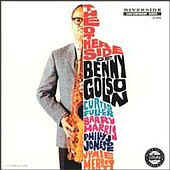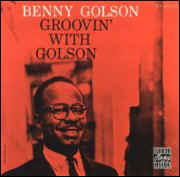Ken Burns Jazz
| Ken Burns Jazz |
| Anthony Callendar — Mr. Kinda Blu |
| 25 April 2001 |
 For weeks people debated the pros and cons of Ken Burns’ mega-documentary Jazz. There were those, and I sympathize with them, who thought that this or that musician should have been mentioned or featured. Still others questioned Burns’ credentials. Yes, Eric Dolphy, master musician, was notably absent. Benny Carter, too. I could name a dozen or so more of my favorites who didn’t even get an honorable mention. But, that’s okay. Still others thought the show reeked too much of Wynton Marsalis and Stanley Crouch and thus was narrower in scope than a history of jazz should have been. No, Messers Marsalis and Crouch have no monopoly on what is jazz or who is a jazz musician. Nether is their word gospel. But I must take my hat off to them both for giving us at least part of the story of how the music I love evolved. Others have argued, and I agree, that Burns did a monumental job of showing how jazz developed and highlighted many of the figures responsible for the great watersheds in a wonderful musical form.
For weeks people debated the pros and cons of Ken Burns’ mega-documentary Jazz. There were those, and I sympathize with them, who thought that this or that musician should have been mentioned or featured. Still others questioned Burns’ credentials. Yes, Eric Dolphy, master musician, was notably absent. Benny Carter, too. I could name a dozen or so more of my favorites who didn’t even get an honorable mention. But, that’s okay. Still others thought the show reeked too much of Wynton Marsalis and Stanley Crouch and thus was narrower in scope than a history of jazz should have been. No, Messers Marsalis and Crouch have no monopoly on what is jazz or who is a jazz musician. Nether is their word gospel. But I must take my hat off to them both for giving us at least part of the story of how the music I love evolved. Others have argued, and I agree, that Burns did a monumental job of showing how jazz developed and highlighted many of the figures responsible for the great watersheds in a wonderful musical form.
Let’s consider this the first chapter, a “To Be Continued.” I watched the series from start to finish and laughed at times and cried, my cheeks flushed as the music as its glory filled my heart. I learned to appreciate Sidney Bechet and Bix Beiderbecke. I bought their CDs, something I thought I would never do. My appreciation of jazz seldom reached back before the bebop days of the 1940s. I heard more music of my parent’s generation than ever before – Count Basie, Fletcher Henderson, Duke Ellington, the Savoy Sultans, the dance music that rocked the world. I learned about and enjoyed the music of their white contemporaries, such as Benny Goodman and Artie Shaw. And not only did it all swing, but it flowed and flowed and flowed. Down through the years Burns hit the highs and lows of jazz, and he did it exceptionally well. As soon as I get my hands on some extra ducats I am going to plunk down the yard and change to pick up the DVD set.
As to what Burns omitted, there are filmmakers, musicians and documentarians who can get us started on chapter two. As noted, great musicians were not even mentioned. Possible projects could address the contribution that several locales have made to jazz – Brooklyn, Chicago, Detroit, Los Angeles, Manhattan, Nashville, Philadelphia, Pittsburgh, San Francisco, St. Louis, etc. Other possible topics might include instrument histories featuring outstanding soloists. What about the loft scene and various avant-garde groups and venues? There is still much to be done.
Life Goes On
James Louis Johnson, a.k.a. J. J. Johnson, the king of “bones,” passed from this life on February 11, 2001 at the age of 77. When I first heard his music I did not know what instrument he was playing. He revolutionized the jazz trombone and made it possible for his fellow instrumentalists to speak the language of bop. J. J. was so precise with the slide that I thought he must have been playing a valve trombone. The first time that I heard him and recognized him was on his two volume album The Eminent J. J. Johnson on the Blue Note label. I am not qualified to eulogize J. J., but if you want to have some idea as to what he was about listen to the following sides:
J. J. Johnson Jazz Quintets (Savoy SV0151), with, among others, Cecil Payne (bs), Bus Powell (p), Max Roach (ds), Leo Parker (bs), Hank Jones (p), and Sonny Rollins (ts).
Jay & Kai (Savoy SV0163), with among others Kai Winding (tb), Charles Mingus (b), Kenny Clarke (ds), Leo Parker (bs), and Hank Jones (p)
Say When (Bluebird-RCA 6277-2RB), with several all-star big bands.
The Complete Columbia J. J. Johnson Small Group Sessions (Mosaic 169)
Let’s say so long, for now, to J. J. The rest is on you…
What’s New
Benny Golson’s new recording, One Day, Forever (Arkadia Jazz – 70744), is interesting. It features old Jazztet mates Curtis Fuller and the late Art Farmer, and Shirley Horn is a special guest on two of the tracks with strings. Benny has also been with the Jazz Messengers. He has written, played and been there for us musically for decades. He is one of the unsung heroes of our time. “I Remember Clifford,” “Moanin,” “Along Came Betty,” and “Killer Joe”, are a few of the priceless gems that are his gifts to us. Other recommended recordings by Benny Golson:
 The Other Side of Benny Golson (OJCCD-1750-2), with Curtis Fuller (tb), Barry Harris (p), Jymie Merritt (b), Philly Joe Jones (ds)
The Other Side of Benny Golson (OJCCD-1750-2), with Curtis Fuller (tb), Barry Harris (p), Jymie Merritt (b), Philly Joe Jones (ds)
 Groovin’ with Golson (OJCCD-226-2), with Curtis Fuller (tb), Ray Bryant (p), Paul Chambers (b), Art Blakey (ds)
Groovin’ with Golson (OJCCD-226-2), with Curtis Fuller (tb), Ray Bryant (p), Paul Chambers (b), Art Blakey (ds)
Must Getz
People often play the music of Kenny “G” to establish a mood for romance. It is rumored that the ladies really dig the way Kenny “G” plays the soprano sax. However, if you really want to set a romantic mood, check out Coleman Hawkins’ At Ease With Coleman Hawkins (Prestige/Moodsville OJCCD 181-2 (MV-7). Words cannot describe what “The Hawk” does with the tenor saxophone. Just listen to “For You, For Me, Forevermore,” “Mighty Like A Rose,” Dawning,” and “Trouble Is a Man.” You must getz this one and set aside some time with your honey to be At Ease together!
Oh, before I forget, check out what’s happening at the Knitting Factory on May 5, 6, and 7. The magnificent Malachi Thompson and his fabulous Free-Bop Band are going to be there doing a thing on Miles. Be there!
![]()
Don’t forget to bookmark us! (CTRL-D)
Stereo Times Masthead
Publisher/Founder
Clement Perry
Editor
Dave Thomas
Senior Editors
Frank Alles, Mike Girardi, Russell Lichter, Terry London, Moreno Mitchell, Paul Szabady, Bill Wells, Mike Wright, and Stephen Yan,
Current Contributors
David Abramson, Tim Barrall, Dave Allison, Ron Cook, Lewis Dardick, John Hoffman, Dan Secula, Don Shaulis, Greg Simmons, Eric Teh, Greg Voth, Richard Willie, Ed Van Winkle, Rob Dockery, Richard Doran, and Daveed Turek
Site Management Clement Perry
Ad Designer: Martin Perry





Be the first to comment on: Ken Burns Jazz